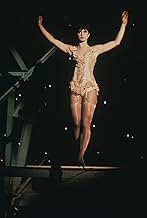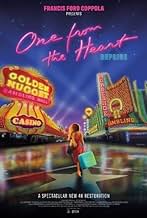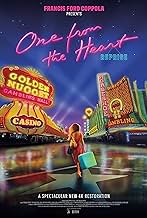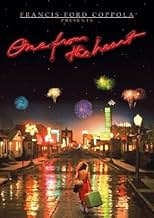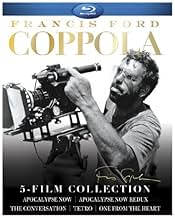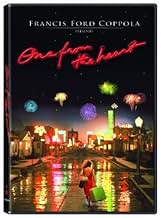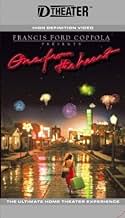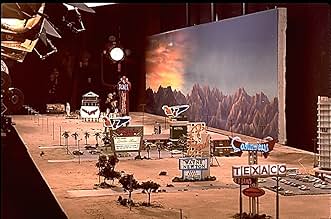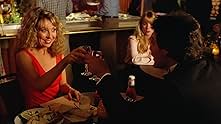AVALIAÇÃO DA IMDb
6,5/10
8,7 mil
SUA AVALIAÇÃO
Um casal tem uma briga depois de viverem juntos por cinco anos em Las Vegas. Eles saem e comemoram o 4 de julho, cada um com um novo parceiro.Um casal tem uma briga depois de viverem juntos por cinco anos em Las Vegas. Eles saem e comemoram o 4 de julho, cada um com um novo parceiro.Um casal tem uma briga depois de viverem juntos por cinco anos em Las Vegas. Eles saem e comemoram o 4 de julho, cada um com um novo parceiro.
- Direção
- Roteiristas
- Artistas
- Indicado a 1 Oscar
- 2 indicações no total
Nastassja Kinski
- Leila
- (as Nastassia Kinski)
Allen Garfield
- Restaurant Owner
- (as Allen Goorwitz)
Rebecca De Mornay
- Understudy
- (as Rebecca de Mornay)
Judith Burnett
- Eleanore
- (não creditado)
Avaliações em destaque
Most general accounts of Francis Ford Coppola's work have identified recurrent familial themes, while visually he has come to be understood as something of a guru of the extravagant. However, neither of these positions is entirely sustainable across an oeuvre that on closer inspection discloses considerable formal and thematic scope. If Coppola had by the close of the 1970s figured, understandably enough, that his career was blessed, this, his next venture, would bring about a very hasty and categorical fall from grace. Initially conceived as a modest antidote to the excesses of Apocalypse Now, the project ballooned into an experiment of gargantuan, tragic proportions that subsequently marked an immediate shift in his career to more modest productions.
This Oscar-nominated Vegas-set semi-musical, which led to Coppola's bankruptcy, is an intriguing production but not a good film. From Coppola, the inspired mastermind of The Conversation, Apocalypse Now and the Godfather films, it's a foremost letdown. A movie's innovative technical process is indeterminate. Movies make or break as per the substance of their material. The most miserable thing about this lavish exercise in style is that it has none. It's a tango of elegant and byzantine camera movements filling wonderful sets, and the characters get completely misplaced in the thick. There's never a second in this film when I'm concerned about what's happening to the people in it, and but one moment, a cameo by Allen Goorwitz as a furious coffee shop owner, when I feel that an actor's artlessness successfully slips past Coppola's suffocating panache and into the audience.
The raconteur of The Godfather turns into a pure technician here. There are unsettling congruences between Coppola's fanatical command of this film and the character of Harry Caul, the wiretapper in Coppola's The Conversation, who cared solely about technical outcomes and declined to let himself consider human ones. Movies are innumerable different things, but most of the best ones are about and for people, and this unmistakably hallucinatory and dreamlike piece of filmmaking takes little notice of the difficulties of the human spirit. Certainly, it appears virtually on the lookout against the actors who inhabit its painstakingly designed scenes. They're scarcely ever permitted to lead. They're figures in a larger blueprint, one that ebbs them, that views them as part of the furnishings. They aren't offered many close-ups. They're frequently suffused in loud red glimmering or overpowering blues and greens. They're positioned before off-puttingly glitzy sets or adrift shoddily stage-managed hordes. And occasionally they're interrupted at the heart of a sentiment because the uncompromisingly planned camera has affairs elsewhere.
I've forgotten, indeed, to mention the players, or who they play. That's not so much of an omission talking about a film like this. The two leads, the sexier-than-ever Teri Garr and the forgettable-as-ever Frederic Forrest occupy a Las Vegas of regret, languor, and glitzy lights. For a short time, they spring from their monotonous lives and meet new lovers, Raul Julia and Natassja Kinski, who string them along with flights of the imagination. In effect, Coppola's telling the simple story of a break-up but with the hyper-romantic lusciousness of the emotions we feel in those times, which is cool, until it becomes an unmotivated, auto-pilot story upstaged by its own, well, stages.
There are trivial amusements in this movie. One is Harry Dean Stanton's phone-in as a sleazy junkyard owner, while Coppola defies showing us Stanton's most valuable instrument, his telling eyes. Kinski, as a circus tightrope walker, has a pretty decent blip on the radar when she explains "to make a circus girl disappear, all you have to do is blink." Garr is endearing, but her role makes her unrewardingly submissive, and Forrest is more or less transparent here, playing such a nonentity. Ho hum.
This Oscar-nominated Vegas-set semi-musical, which led to Coppola's bankruptcy, is an intriguing production but not a good film. From Coppola, the inspired mastermind of The Conversation, Apocalypse Now and the Godfather films, it's a foremost letdown. A movie's innovative technical process is indeterminate. Movies make or break as per the substance of their material. The most miserable thing about this lavish exercise in style is that it has none. It's a tango of elegant and byzantine camera movements filling wonderful sets, and the characters get completely misplaced in the thick. There's never a second in this film when I'm concerned about what's happening to the people in it, and but one moment, a cameo by Allen Goorwitz as a furious coffee shop owner, when I feel that an actor's artlessness successfully slips past Coppola's suffocating panache and into the audience.
The raconteur of The Godfather turns into a pure technician here. There are unsettling congruences between Coppola's fanatical command of this film and the character of Harry Caul, the wiretapper in Coppola's The Conversation, who cared solely about technical outcomes and declined to let himself consider human ones. Movies are innumerable different things, but most of the best ones are about and for people, and this unmistakably hallucinatory and dreamlike piece of filmmaking takes little notice of the difficulties of the human spirit. Certainly, it appears virtually on the lookout against the actors who inhabit its painstakingly designed scenes. They're scarcely ever permitted to lead. They're figures in a larger blueprint, one that ebbs them, that views them as part of the furnishings. They aren't offered many close-ups. They're frequently suffused in loud red glimmering or overpowering blues and greens. They're positioned before off-puttingly glitzy sets or adrift shoddily stage-managed hordes. And occasionally they're interrupted at the heart of a sentiment because the uncompromisingly planned camera has affairs elsewhere.
I've forgotten, indeed, to mention the players, or who they play. That's not so much of an omission talking about a film like this. The two leads, the sexier-than-ever Teri Garr and the forgettable-as-ever Frederic Forrest occupy a Las Vegas of regret, languor, and glitzy lights. For a short time, they spring from their monotonous lives and meet new lovers, Raul Julia and Natassja Kinski, who string them along with flights of the imagination. In effect, Coppola's telling the simple story of a break-up but with the hyper-romantic lusciousness of the emotions we feel in those times, which is cool, until it becomes an unmotivated, auto-pilot story upstaged by its own, well, stages.
There are trivial amusements in this movie. One is Harry Dean Stanton's phone-in as a sleazy junkyard owner, while Coppola defies showing us Stanton's most valuable instrument, his telling eyes. Kinski, as a circus tightrope walker, has a pretty decent blip on the radar when she explains "to make a circus girl disappear, all you have to do is blink." Garr is endearing, but her role makes her unrewardingly submissive, and Forrest is more or less transparent here, playing such a nonentity. Ho hum.
I have never been in the United States, least of all in New York. But through some directors' works I have built up an image of the city that never sleeps that's made of jazz, petty crooks and gangsters, Godard-lovers, intellectual wanna-be socialite... For all I know, New York is what can be seen through the eyes of Woody Allen, Martin Scorsese... and Francis Ford Coppola.
I would pretty much compare ONE FROM THE HEART to Allen's MANHATTAN, in the sense that both are new-yorkers visions of romance and beauty, filtered through a broadway theatrical and glamorous sensibility. This film, however, unlike MANHATTAN, isn't about New York. It's about spining through the spotlights of a city that parties all night long (cabarets, jazz, dance and magical flirts), only to realize that in the end, it's going to be your simple significant other waiting for you in the backstage.
The staging of the whole movie helps a lot, in the sense that's it's all filmed in studio. Magical skies and dawns that make it easy to pass from a store-window directly to a sunset in Bora-Bora; lust and life and music in what I would consider the last great musical. Every once in a while, Coppola gives us a glimpse of his more passionate side. This would then be the sunny side of the melancholic DRACULA.
Add to the magical staging the nightly cabaret-like musical score by Tom Waits and Crystal Gayle and one can't help but be amazed with it all. And I thought I was surprised by Woody Allen's EVERYONE SAYS I LOVE YOU.
If this is the way new-yorkers see life, that's the city I want to live in.
I would pretty much compare ONE FROM THE HEART to Allen's MANHATTAN, in the sense that both are new-yorkers visions of romance and beauty, filtered through a broadway theatrical and glamorous sensibility. This film, however, unlike MANHATTAN, isn't about New York. It's about spining through the spotlights of a city that parties all night long (cabarets, jazz, dance and magical flirts), only to realize that in the end, it's going to be your simple significant other waiting for you in the backstage.
The staging of the whole movie helps a lot, in the sense that's it's all filmed in studio. Magical skies and dawns that make it easy to pass from a store-window directly to a sunset in Bora-Bora; lust and life and music in what I would consider the last great musical. Every once in a while, Coppola gives us a glimpse of his more passionate side. This would then be the sunny side of the melancholic DRACULA.
Add to the magical staging the nightly cabaret-like musical score by Tom Waits and Crystal Gayle and one can't help but be amazed with it all. And I thought I was surprised by Woody Allen's EVERYONE SAYS I LOVE YOU.
If this is the way new-yorkers see life, that's the city I want to live in.
Many film fans are keenly aware of the circumstances surrounding Francis Coppola's "One From the Heart." It was the first film to launch his self financed Zoetrope Studios. He recruited many of the industries best and brightest for the production. It was Coppola's follow up to the legendary "Apocalypse Now." The film was supposed to mark a new direction for filmmaking as a whole. Zoetrope was to be a place where directors and storytellers could produce their films without studio interference. The artists would control the medium, not the business men. And with "One From the Heart", Coppola's dream came to a thundering halt after just one movie. Though not as well known, it stands along side "Heaven's Gate" as a film that proved that the wonder directors of the 70's would not be given the keys to the castle. "Heart" was that once in a decade disaster and it's not hard to see why it was such an ignored film. It turns out that this story behind the film is far more interesting to follow than the film itself.
"One From the Heart" is as stylized as films can come. Shot entirely on the sets at Zoetrope, "Heart" attempts to tell the story of Franny and Hank, a long together couple possibly nearing the end of their rope with one another. The couple calls it quits and they seek solitude in the arms of more adventuresome lovers for one night in an entirely reproduced Las Vegas. Coppola's decision to cast Frederic Forest and Teri Garr seems daring at first, almost brave. But casting two such down to Earth actors against the overwhelming design of "One From the Heart" leaves the two with nothing to do but drown under the neon cinematography. Garr and Forest give it a go, but their problems seem minor against the wave of the film itself. It's possible no two actors could've asserted themselves against this backdrop. Coppola has infused every shot in "Heart" with enough technique and design that he seems to have completely forgotten to add any element of genuine drama into the proceedings. The story never moves far beyond the 'will they stay together or break up' arc. It isn't without possibility, but it's more suited to a smaller more intimate scale, not the phantasmagoric, neon coated reality that constantly draws attention to itself that Coppola labors to construct. All the design is admirable and on occasion very gorgeous. But it won't take an astute viewer very long to see that "One From the Heart" is a film more intended to be looked at than actually watched. A technological achievement in filmmaking? Yes. A genuinely involving film? No.
Despite disliking the film I'm glad to see it's finally available on DVD in a watchable format. Viewers can finally see this much maligned film for themselves and decide about its merits. The film is also noted for it's songs and score by Tom Waits and Crystal Gail.
"One From the Heart" is as stylized as films can come. Shot entirely on the sets at Zoetrope, "Heart" attempts to tell the story of Franny and Hank, a long together couple possibly nearing the end of their rope with one another. The couple calls it quits and they seek solitude in the arms of more adventuresome lovers for one night in an entirely reproduced Las Vegas. Coppola's decision to cast Frederic Forest and Teri Garr seems daring at first, almost brave. But casting two such down to Earth actors against the overwhelming design of "One From the Heart" leaves the two with nothing to do but drown under the neon cinematography. Garr and Forest give it a go, but their problems seem minor against the wave of the film itself. It's possible no two actors could've asserted themselves against this backdrop. Coppola has infused every shot in "Heart" with enough technique and design that he seems to have completely forgotten to add any element of genuine drama into the proceedings. The story never moves far beyond the 'will they stay together or break up' arc. It isn't without possibility, but it's more suited to a smaller more intimate scale, not the phantasmagoric, neon coated reality that constantly draws attention to itself that Coppola labors to construct. All the design is admirable and on occasion very gorgeous. But it won't take an astute viewer very long to see that "One From the Heart" is a film more intended to be looked at than actually watched. A technological achievement in filmmaking? Yes. A genuinely involving film? No.
Despite disliking the film I'm glad to see it's finally available on DVD in a watchable format. Viewers can finally see this much maligned film for themselves and decide about its merits. The film is also noted for it's songs and score by Tom Waits and Crystal Gail.
Maybe this isn't a masterpiece, but this Las Vegas musical shot entirely on a soundstage was wildly underrated. The film is as daring as any of Coppola's other works. With enjoyable performances and the great Tom Waits/Crystal Gayle songs, slick camera work and colorful neon, there was no reason for this film to get kicked as hard as it did. Who know, maybe it is a masterpiece.
Yes, this movie did absolutely horrible in theaters when it was released in 1982. I saw it about 1984 on disk (CED) and was surprised. Along with the weird lighting (it was filmed on a HUGE sound stage) and strange character reactions....something in this move touched me deeply. Along with all of it I found a kernal....a morsel......some real gem that made this otherwise trite movie quite rich. Rich enough I saw the movie again....and am considering purchase of a copy.
Apparently I am one of the 5% who actually LIKED the movie....who didn't demand their ticket money back.
We DO exist, you know....
Apparently I am one of the 5% who actually LIKED the movie....who didn't demand their ticket money back.
We DO exist, you know....
Você sabia?
- CuriosidadesOriginally intended as a small film after the enormous cost, pressures, and production problems of Apocalypse Now (1979), this film's budget ballooned from $2 million to over $25 million. The extraordinary costs led to director Francis Ford Coppola declaring bankruptcy. Coppola has stated that the films he made were done to pay off the debts incurred producing this film.
- Erros de gravaçãoWhen Hank removes Frannie from Ray's room, Ray puts on a robe, and he is not wearing any underwear. However, after Ray yells at Hank from the balcony, his robe falls open, and he is shown wearing jockey shorts.
- Cenas durante ou pós-créditosIn the opening credits, the names of crew members appear in the neon signs of Vegas casinos and hotels.
- Versões alternativasThree versions exist. The theatrical version; 103 minutes The restored version, release in 2003; 99 minutes Reprise version, release in 2023; 93 minutes The story is generally the same. But they have many changes, cut or altered shot.
Principais escolhas
Faça login para avaliar e ver a lista de recomendações personalizadas
- How long is One from the Heart?Fornecido pela Alexa
Detalhes
- Data de lançamento
- País de origem
- Central de atendimento oficial
- Idiomas
- Também conhecido como
- Una del corazón
- Locações de filme
- Empresa de produção
- Consulte mais créditos da empresa na IMDbPro
Bilheteria
- Orçamento
- US$ 26.000.000 (estimativa)
- Faturamento bruto nos EUA e Canadá
- US$ 697.872
- Fim de semana de estreia nos EUA e Canadá
- US$ 389.249
- 14 de fev. de 1982
- Faturamento bruto mundial
- US$ 719.534
- Tempo de duração
- 1 h 47 min(107 min)
- Cor
- Proporção
- 1.37 : 1
Contribua para esta página
Sugerir uma alteração ou adicionar conteúdo ausente



